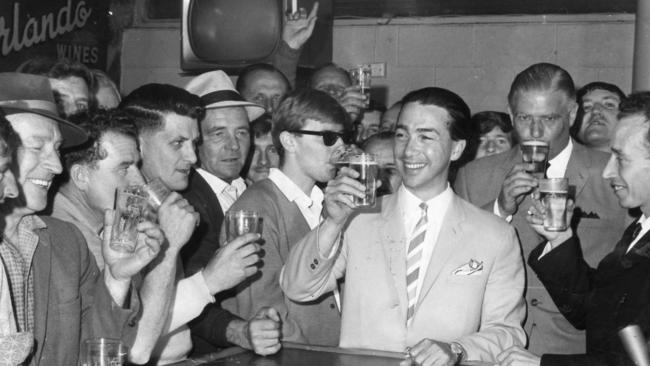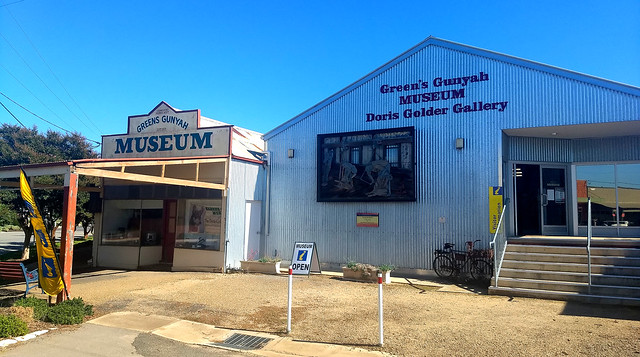Wednesday, December 15, 2021
The history of Australian Riverboats
Paddle-steamers and riverboats were vital to the opening up and development of Australia. While ocean-going ships brought people to Australia, it was the river system and river trade that opened up the whole south-east corner of the continent.
Tuesday, December 14, 2021
Rediscovering Swan Reach SA
#SouthAustralia
Prior to the arrival of Europeans in 1836, the custodians of the region were approximately 1200 Ngalawang tribal members. The aborigines lived with nature, while the white man tried to tame it. Living along the river on a semi-permanent basis, they used the skins from their catches to ward off the cold during winter, made an arrangement of baskets from the reeds, built low stone walls across the river to trap fish, in all, surviving a healthy lifestyle.
Wednesday, October 13, 2021
Six spooky experiences to try this coming Halloween
From unleashing your inner ghostbuster to investigating crime scenes and being part of a supernatural interactive theatre show, there’s something for everyone.
Friday, September 10, 2021
Hahndorf: The Studio of Nora Heysen
#AdelaideHills
Nora Heysen is recognised as one of Australia's most significant 20th-century female artists, being the first woman to win the Archibald Prize (1938), and the first woman appointed as an Australian War Artist (1943-46). Her art is in the collections of the Australian War Museum, the National Gallery, National Portrait Gallery and the National Library, together with state and regional art galleries, and numerous private collections.
Tuesday, September 7, 2021
Meals on Wheels: Sydney and NSW Food Trucks
There's a unique kind of joy to sitting on a milk crate with a paper plate laden with flavourful food balancing on your knees. NSW has long had a love affair with food trucks, which shows no signs of abating. Here are some of the tastiest in town:
Monday, September 6, 2021
Ten Virtual Travel Experiences you can enjoy from home
For the chefs who want to learn how to make more than just banana bread
Small Group Authentic Mumbai Virtual Cooking Class with Dessert
Learn how to make Pav Bhaji and Rice Kheer from Kajal. Based in Mumbai, Kajal picked up authentic home-style family recipes from her mom and sister. In 2017 she started hosting food tours and Pav Bhaji was always one of the most popular dishes. This Maharashtrian delicacy is a thick vegetable curry made from seasonal vegetables, potatoes, tomatoes and onions served with pav, which is a bread roll topped with butter and best served hot. The word 'pav' comes from the Portuguese word for bread and 'bhaji' in Marathi means a vegetable dish.
Sunday, August 29, 2021
Don Dunstan ends Adelaide's Six O'Clock Swill
A volunteer at the Magill RSL was in the crosshairs of prosecutors in 1947 for an offence that, these days, we would see as innocuous on a Friday night.
Tuesday, August 17, 2021
Monday, August 9, 2021
Adelaide's Historic Ayers House Future Under Threat
 |
| Photo: The Advertiser |
| Warren Jones Journalist Adelaide East Herald |
The future of the historic Ayers House and museum is under threat.
On 10th June 2021, an eviction notice from the Minister for Environment and Water and his Departmental Head was hand-delivered to the National Trust of SA demanding that it vacate the property within 31 days.
Following difficult negotiations, the eviction deadline was extended to September.
This is an unprecedented and unwarranted attack on the fifty-year stewardship of Ayers House by the National Trust, a body which, for 65 years, has nurtured and safeguarded much of South Australia's built and natural heritage.
Thursday, July 15, 2021
Everything you need to know about Cloncurry, Queensland
It's the little Outback Queensland town with a gutsy big past, but for most Australians, Cloncurry is about to go on record as the mightiest backdrop of any Survivor series when the 2021 production goes to air starting July 18. Thanks to its spectacular sunsets, rugged rocky outcrops and a population of a few thousand residents who helped the town take out “Queensland's friendliest” in 2013, the “Curry” (as it's affectionately dubbed) is about to explode onto our Road Trippin Radar.
Wednesday, July 14, 2021
10 wine experiences you must try in Australia

Tuesday, July 13, 2021
Two-Wheeled Travellers - Cycling in South Korea
South Korea has one of the most advanced cycling infrastructures in the world and is a popular sport for locals, with trails tailored to families, leisure cyclists and professionals alike. There is an extensive network of bike paths and quiet secondary roads that will take you past areas featuring remarkable Buddhist temples and UNESCO World Heritage sites.
Thursday, July 8, 2021
The battle for Unley's Heywood Park
Unley residents will be familiar with the generous green space of Heywood Park, which lies at the southern end of King William Road.
Friday, June 18, 2021
The Story of the Old Ghan Railway
Great Northern Railway to Asia
The Old Ghan story begins at Port Augusta, South Australia, in 1878 when, with picks and shovels, men began work on a narrow-gauge railway planned to snake its way to Darwin, and a link to Asia.
Saturday, June 5, 2021
Adelaide: The beginnings of King William Road
 |
| Methodist church and hall Goodwood. This church was built in 1880 (SLSA) |
Calm breezes and fruit trees populated the plain to the south of Adelaide in the days before King William Road was built.
Part of the land was the property of John Hyde, a pastoralist and namesake of the suburb that would eventually stand on his property, which was known as 'Hyde Paddocks.
Friday, June 4, 2021
Hotel Stories: Ridgewood Wilderness Lodge, Alaska
To begin with, Lucinda cooks like a professional chef-using organic produce, much of it from her garden and Kevin would be capable of building an entire Alaskan village with his own hands. This is Alaska as you imagine it. This was a trip rich in both flora and fauna: a unique and remarkable natural heritage, an exceptional environmental journey from start to finish.
Tuesday, June 1, 2021
Vanished Adelaide: The Vine Inn, Glen Osmond
Remembering Adelaide's Trams
Before cars became so readily available, public transport was the only viable option for people unless they wanted to be on Shank's pony (ie, walk)
The East Adelaide line was a crucial transport line for locals and ran along Magill Road to Maylands
Thursday, May 27, 2021
Glenside, an Adelaide institution
Glenside Park on the corner of Fullarton and Greenhill Roads was opened on May 9 and will be handed over to Burnside Council early next month.
Saturday, May 1, 2021
Ipoh Old Town
She has been visited by many and forgotten by many as time passed us all by, however, she is back even stronger with a big attitude of hip, retro and gothic. She has and will continue to be visited by many on their transit journeys, food indulgence or just to take a walk into memory lane. Wonder no more! It is no other than Ipoh, the capital city of Perak.
Thursday, April 1, 2021
Visiting Lockhart NSW: Billabong Motors
In 1935 Mr JM Smith established the firm of I M Smith and Co. which carried with it the Ford Company franchise in Urana. The motor business was registered in 1950 under the name of Billabong Motors. In 1959 the Ford Motor Company extended the franchise to take in the Lockhart district. Then in October 1962, the old garage formerly occupied by Mr Darcy McDougall in Urana Street was purchased and the business opened in Lockhart.
Thursday, March 25, 2021
Mapping Australia's coastline
Every map tells a story; it reflects the individual mapmaker's particular perception of the world. Maps are a graphic representation of how we understand the condition of the human world based on concepts and events. They show the location of items and places and the spatial relationship between them. Specific cultural symbols and lines are often used to illustrate geographical features.
Matthew Flinders. Published by Joyce Gold, Naval Chronicle Office, 1814. Courtesy of the National Library of Australia: nla.pic-an9455829-1-v.
European mapping is based on Western concepts as they relate to geographical space. From the early 1500s to the 1800s, maps represented religious and political views of the communities that the map makers were serving as well as the scientific knowledge at the time. Artistic beauty was combined with geographical information because of the intention to sell the map or please a patron or employer.
Friday, March 12, 2021
South Australia: In the beginning
 |
| Colonel William Light |
The instructions issued by the Commissioners concerning the selection of a site for the capital of the new province were as follows:
When you have determined the site of the first town, you will proceed to lay it out in accordance with the regulations. You will make the streets of ample width, and arrange them with reference to the convenience of the inhabitants, and the beauty and salubrity of the town; and you will make the necessary reserves for squares, public walks and quays.
The following letter dated 13 July 1836 (the original of which is in the possession of the Adelaide City Council) from Lieutenant-General Sir Herbert Taylor, Private Secretary to King William IV, to Governor Hindmarsh, communicated the command of the Monarch that the capital of South Australia should be named after his consort, Queen Adelaide.
Wednesday, February 3, 2021
Motorcycle racing history at Woodside, SA
 |
| Motorcycle races at Woodside SA, October 1949. National Motor Museum Collection |
Racing and competition have been an important element of motorcycle culture from the start, beginning with friendly club competitions and road races.
Monday, January 4, 2021
The Stanthorpe Heritage Museum has fifteen buildings and more than 20,000 items

School Residence (1894): The North Maryands schoolhouse features displays of a schoolroom, kitchenalia, religious vestments. banking office and photographic equipment.
Ardmore House (1920): This was one of five summer holiday homes built in Stanthorpe during the 1920s. It houses hospital, ambulance, dental, bathroom, bedroom, music, toy, domestic and textile collections plus the local Italian history.
Sunday, January 3, 2021
Visiting Tibooburra in Outback NSW
There is something impossibly romantic about Tibooburra; there it is in the far north-western corner (Corner Country) of New South Wales. Tibooburra is 335 km north of Broken Hill, 1504 km north-west of Sydney, 900 km from Adelaide. It seems so isolated and yet it is full of friendliness and activity.
Last 30 Days' Most Popular Posts
-
Every July, the sleepy coastal town of Boryeong in South Korea transforms into a muddy playground, attracting thousands of thrill-seekers an...
-
Sydney's Menzies Hotel was opened on 17th October 1963, by Premier R.J. Heffron and named after Sir Archibald Menzies, a pioneer in...
-
Explorers; Hume and Hovell, passed through the region around Gundagai, ancient home of the Wiradjuri people , in November 1824 and by t...
-
Paddle-steamers and riverboats were vital to the opening up and development of Australia. While ocean-going ships brought people to Australi...
-
Like so much of the former French Indochina, there are many stories of days gone by. Here in the centre of Ho Chi Minh City is arguably its ...
-
Indigenous warrior, Jandamarra, led the armed resistance of his Bunuba people At Windjana Gorge on November 7, 1894 Jandamarra appeared on t...
























